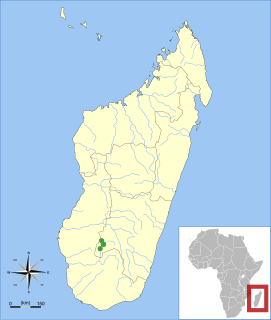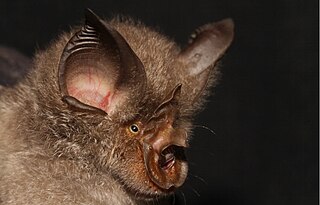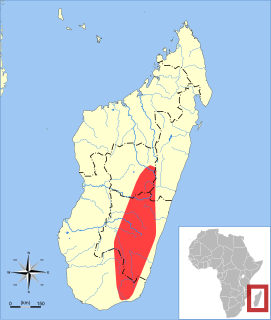
The lesser yellow bat is a vesper bat found only on Madagascar and Réunion. On Réunion, it was considered common early in the 19th century, but was last sighted late in the 19th century. Only a single specimen attributed to this species, collected in 1868, is known from Madagascar. It was listed as a critically endangered species in 1996 due to habitat loss, and may be extinct.

The big crested mastiff bat, is a bat species from South and Central America.

Peters's wrinkle-lipped bat(Mormopterus jugularis), also called Peters's goblin bat, is a species of bat in the family Molossidae, the free-tailed bats. It is endemic to Madagascar, where it is widespread and in some areas abundant. It commonly roosts in human-made structures, sometimes in colonies with other free-tailed bat species. It forages in the open, often in agricultural areas. The bat is sexually dimorphic, with males larger than females.

The robust yellow bat is a species of vesper bat. It is found only in Madagascar.

The little free-tailed bat is a species of the genus Chaerephon in the family Molossidae. It is widely distributed across Africa and islands around the continent.

The Madagascar sucker-footed bat, Old World sucker-footed bat, or simply sucker-footed bat is a species of bat in the family Myzopodidae endemic to Madagascar, especially in the eastern part of the forests. The genus was thought to be monospecific until a second species, Myzopoda schliemanni, was discovered in the central western lowlands. It was classified as Vulnerable in the 1996 IUCN Red List of Threatened Species but is now known to be more abundant and was reclassified in 2008 as of "Least Concern".

The lesser woolly horseshoe bat, also called Beddome's horseshoe bat, is a species of bat in the family Rhinolophidae. It is found in India and Sri Lanka. Its natural habitats are subtropical or tropical moist lowland forests, caves, and urban areas. It is threatened by habitat loss.

Scotophilus is a genus of vespertilionid bats commonly called yellow bats. They are found in southern Asia and Africa.

The western sucker-footed bat is a Malagasy bat. Little is known about its habits, but they are assumed to be similar to those of the Madagascar sucker-footed bat.

Triaenops menamena is a bat in the genus Triaenops found on Madagascar, mainly in the drier regions. It was known as Triaenops rufus until 2009, when it was discovered that that name had been incorrectly applied to the species. Triaenops rufus is a synonym of Triaenops persicus, a Middle Eastern species closely related to T. menamena— the Malagasy species had previously been placed as a subspecies of T. persicus by some authors. Triaenops menamena is mostly found in forests, but also occurs in other habitats. It often roosts in large colonies and eats insects such as butterflies and moths. Because of its wide range, common occurrence, and tolerance of habitat degradation, it is not considered to be threatened.

Pipistrellus raceyi, also known as Racey's pipistrelle, is a bat from Madagascar, in the genus Pipistrellus. Although unidentified species of Pipistrellus had been previously reported from Madagascar since the 1990s, P. raceyi was not formally named until 2006. It is apparently most closely related to the Asian species P. endoi, P. paterculus, and P. abramus, and its ancestors probably reached Madagascar from Asia. P. raceyi has been recorded at four sites, two in the eastern and two in the western lowlands. In the east, it is found in open areas and has been found roosting in a building; in the west it occurs in dry forest. Because of uncertainties about its ecology, it is listed as "Data Deficient" on the IUCN Red List.

The Isalo serotine is a vespertilionid bat of Madagascar in the genus Neoromicia. It is known only from the vicinity of the Isalo National Park in the southwestern part of the island, where it has been caught in riverine habitats. After the first specimen was caught in 1967, it was described as a subspecies of Eptesicus somalicus in 1995. After four more specimens were collected in 2002 and 2003, it was recognized as a separate species. Because of its small distribution and the threat of habitat destruction, it is considered "vulnerable" in the IUCN Red List.

Smithers's horseshoe bat is a species of horseshoe bat found in South Africa and Zimbabwe. It was described as a new species in 2012.

The Marovaza house bat is a species of bat found in Madagascar.
Rhinolophus microglobosus is a species of horseshoe bat found in Southeast Asia.

Neoromicia robtertsi is a species of vesper bat found in Madagascar. It is a recently described species, as it was first described in 2012.

The western sheath-tailed bat is a species of sac-winged bat found in Madagascar.

Miniopterus sororculus is a species of bat endemic to the highland forests of Madagascar.
Hipposideros atrox, commonly known as the lesser bicolored leaf-nosed bat, is a species of bat found in Southeast Asia. Originally described as a subspecies in 1918, it was recognized as a full species in 2010. It uses echolocation to navigate and find prey, and roosts in caves during the day.


















